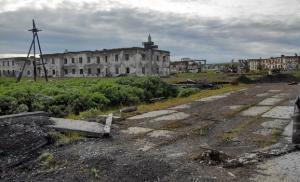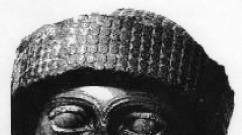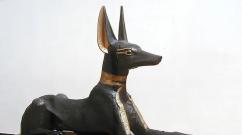Is the badger omnivorous or not? European badger: habitat, description, food
The badger is one of the representatives of the mustelid family. He is the largest representative in his family. Badger weight in summer period is 20-24 kg, before hibernation its weight can increase to 34 kg. The badger reaches a length of 90 cm. The body is strong and wedge-shaped. The badger's coat is thick and long, with an additional undercoat. The head is round in shape with a pointed muzzle at the end and a short, almost invisible neck. The ears are small and rounded at the end. The limbs are short and massive with long claws on the toes that are excellent for digging. The badger also has a tail, its length is 20-24 centimeters. The body color is brownish-gray with a silvery tint. The badger's muzzle is white with two black stripes running along the eye line from the nose to the ears. The tips of the ears are white.
The most developed sense The badger has a sense of smell and hearing. Badgers see poorly both far and close.
Lifestyle
Badgers live in families or alone. It all depends on population density. If the population in one area is very large, badgers live in small family groups. Such groups have a main burrow, a head of the family (mostly the oldest male of the group) and a dominant female. The total area of the family plot can range from 35 to 400 hectares.
On the borders of their towns, badgers leave marks with a characteristic musky odor, which is the same for all family members. With the help of this smell, badgers of this family recognize each other. They leave their excrement as boundaries for strangers.
In conditions where the population density is low, badgers lead a solitary lifestyle without identifying a main burrow.
Where does the badger live?
The badger lives throughout almost the entire territory of Europe except Finland and the northern part of the Scandinavian Peninsula. In addition to Europe, another type of badger is found in Asia (Asian badger). There is also another species that is distributed throughout North America - the American badger.
Although the badger's habitat is quite wide, it is difficult to meet one in the forest great luck. This is due to the fact that the badger leads night look life, this is a very cautious animal that tries to avoid any danger by hiding in its holes.
In forests, the badger prefers to settle in places where there is a lot of grass and bushes. To build its dwellings, it uses places with the most convenient soil for digging holes (edges, slopes and beams).

What does a badger eat?
The badger is an omnivorous animal. Its diet depends on the time of year. Goes hunting at night. In summer it eats mainly rodents, lizards, frogs, insects and their larvae, earthworms, slugs, mollusks, small birds, eggs. Also at this time of year he eats berries, grass, mushrooms, nuts, fruits, and plant bulbs. In autumn, it often feeds in agricultural fields, eating up crops, legumes, corn and other cultivated plants.
Research on the badger in Ukraine has shown that its diet consists of more than 49 plant species and 54 animal species. But in some countries, for example, England, the main food for badgers is earthworms, other types of feed are of secondary importance.
Badger's home
Badgers live in burrows that they dig themselves. A badger's burrow consists of several long tunnels, entrance holes and nesting chambers. Sometimes the length of the tunnels in one burrow reaches 5-10 meters, and the number of passages into the dwelling can number up to 50 holes. As a rule, badgers have 2 or 3 nesting chambers. He carefully monitors each chamber, constantly changing the bedding. Badgers arrange their nesting chambers so that neither rain nor groundwater can seep into them.
Badgers spend most of their lives in their homes.
How does a badger winter?
During almost the entire summer and half of the fall, the badger prepares for hibernation, accumulating additional fat during this period to survive the winter. This is the only representative in its family that sleeps in winter. The rest of the mustelids are active all year round.
With the arrival of November at the beginning of December badger hibernates. In some more northern regions he sleeps already in mid-October or early November.
Sometimes in winter badgers can wake up and come out of their holes. This happens most often during periods of winter thaw.
In countries with warmer climates, badgers do not sleep in winter; there they lead active image life all year round. 
Badger breeding
The mating season for the common badger lasts from February to September. Fertilized females bear offspring only for next year after mating. Pregnancy can last from 270 to 450 days, it all depends on when mating occurred. Females bring offspring in the southern part of Europe at the end of December at the beginning of April, in the northern part - in March-April.
Usually 2-3 babies are born in one litter. Maximum quantity The number of babies a female can bring is 6. Badgers are born deaf and blind. They begin to hear within a month, and open their eyes only at five weeks of age.
For newborn babies, the first year of life is one of the most dangerous and difficult; at this time, badger cubs are most vulnerable.
Babies learn to get food at the age of 3-3.5 months. With the transition to independent feeding, badger cubs quickly gain weight and by the fall they catch up with their parents in size.
Lifespan of a badger V wildlife on average is 5-6 years. Long-livers are considered to be individuals who have lived up to 10-12 years. Badgers can live longer in captivity. The oldest long-lived badger lived for 16 years. 
Badger and man
The badger does not pose a direct threat to humans. But at the same time, he suffers from a dangerous disease for humans - rabies. Previously, it was believed that the badger also carries tuberculosis of the large cattle, but recent studies have confirmed that the badger is not a carrier of bovine tuberculosis.
Due to the fact that the badger can carry these diseases, they continue to actively destroy it. To prevent hunting of badgers, in Europe they are vaccinated in natural conditions. In addition to exterminating the badger as a carrier of diseases, it is hunted in Russia and Ukraine in order to use its fat in alternative medicine.
In addition to the above reasons for extermination, the badger is destroyed as a crop pest. Although it brings much more benefit to a person than harm. In his diet a large number of agricultural pests.
As a result of such mass extermination, the badger became endangered and was listed in the Red Book International Union nature conservation.
Badgers live in Europe, Crimea, Central Asia, the Caucasus and the Far East.
They prefer to settle near bodies of water in dry areas in mixed taiga forests, less often they can be found in the mountains and steppes.
It has a dense, muscular body, up to one meter long, short legs with blunt claws.
The claws are very strong, the fingers are thick - this is an excellent adaptation for digging the ground. The muzzle is elongated, the neck is short, the ears and eyes are small.
The tail length is no more than 25 cm, and the animal weighs from 20 to 24 kilograms. Before hibernation, it accumulates fat, then its weight reaches 34 kg.
The coat is coarse, the color is brown-gray, the abdomen and paws are black. There are two black stripes on the white muzzle and a white tail.

The animals live in colonies in one large “burrow”. There are dozens of passages in such a hole, and cozy nesting chambers are located on three floors, up to three meters deep. There are also spare holes and storerooms. The badger's house is clean, he regularly changes his bedding, and he goes to the toilet along a path to the same place not far from the house.
The lifestyle of this species is nocturnal. It feeds on earthworms, lizards, and eggs. Don't mind eating nuts, berries and mushrooms. He eats grass regularly. He eats only half a kilo of food a day. But by winter, it actively accumulates fat, which is useful during hibernation.

badger hole photo
He also makes supplies, bringing seeds, acorns, roots and even frogs, probably dried, to the pantry. Hearing and smell are well developed, vision is slightly worse, the animals are myopic.
Pregnancy lasts from 271 to 450 days, depending on the time of year. Up to 6 blind babies are born. They are helpless and have sparse white hair on their body. The eyes open after 35 days. They eat mother's fatty, nutritious milk.

The badger is a large representative of the mustelid family (Mustelidae). His English name badger comes from the French becbeur, which means “digger.”
Badgers are found in Africa, Eurasia and North America. They descended from a marten-like ancestral form that inhabited rainforests Asia. Species such as teledu, Malayans and ferrets still inhabit this region today.
Common badgers are more widespread. They live over a vast area stretching from Ireland to Japan, including Mediterranean islands with an arid climate, northern forests Scandinavia, as well as the semi-deserts of Israel and Jordan. They are most numerous in areas of mosaically scattered forests and pastures; large forest areas try to avoid. This species is also found in the outskirts of cities, city parks and gardens.
In Russia, the badger lives almost everywhere. Ural mountains; there is no one only far north and in areas with very dry terrain.
In total, there are 10 species of badgers in 6 genera. Let's get to know them better.
Badger subfamily (Melinae)
This subfamily includes 8 species in 4 genera.
The common badger (Meles meles) is found in the forests and steppes of Europe, in Asia south to Palestine and Iran, east to eastern China, Korea, and Japan. The color is gray-black above, gray below. It is distinguished by alternating white and black stripes on its face. A black stripe runs from the nose to the ear on each side.
The Javanese (Mydaus javanensis) lives in Borneo, Java, and Sumatra. The color is dark brown or blackish. On the head and back there is white stripe or a series of white spots.

The Palawan (Mydaus marchei) lives in the grassy plains and farmlands of the islands of Palawan and Busuanga. The color on top is dark brown to black, the muzzle is white with a yellowish tint, and a yellowish stripe runs down the back.

Teledu (Arctonyx collaris) lives in the forest zone of China and Indochina, as well as in Sumatra and Thailand. The back is yellow, gray or blackish, the ears and tail are white, the belly and limbs are black; dark stripes on the muzzle extend through the eyes.

Ferret badgers
4 species of the genus Melogale: Burmese (India, Nepal), eastern ( Southeast Asia, Java, Bali), Chinese (China, Taiwan, Burma), Everett ferret badger (Borneo).

Subfamily Honeyeaters Mellivorinae
The honey badger (Mellivora capensis) is the only representative of the genus. Lives in savannas and dense forests Africa. Top part white from head to tail, often mixed with gray or brown. The sides, underbody and limbs are black.

Subfamily Taxidienae
The American badger (Taxidea taxus) is the only species of the genus. Found from southeastern Canada and the north central United States to Mexico in the south. It is easily recognized by its reddish-gray fur on its back and white stripe on its face.

The body length of these animals ranges from 32 cm (Palawan, ferret) to almost 1 meter (common). They weigh, depending on the type, from 2 to 24 kilograms. The body of the animals is massive, squat; in shape it resembles a heavy drop, gradually expanding from the muzzle to the tail. In appearance, they are similar to other members of the family (mink, weasel) only with short legs.
The fur of the animals is long and thick, but rough. The muzzle of all species is colored in a unique way: from clearly defined stripes in the common badger to the characteristic mask in ferrets.
The common, American and Malayan species are perfectly adapted to burrowing. They have a dense body, short limbs, well-developed muscles and powerful claws. The Javan species has fused toes on the front feet, which is probably a special adaptation for digging. Taxidea taxus are such excellent diggers that in case of danger they can dig an escape shelter and disappear from the enemy’s sight in just a couple of minutes. In contrast, primitive ferret badgers more closely resemble martens.
Lifestyle in nature
The badger is active at dusk and at night, in daylight hours It can be seen very rarely during the day.

Most species are characterized by a solitary lifestyle. Only Meles meles prefer to live in families. On common territory up to 20-25 individuals can live in one or several common burrows. Interesting distinctive feature animals is the lack of a stable social hierarchy between adults.
Reasons why common badgers live in groups, not entirely clear. Perhaps this is due to weather conditions and availability of feed, since this is typical only for areas with temperate climate and fairly high precipitation levels. In places where food resources are limited and the climate is arid, animals prefer to live in pairs over a large area of 4-5 km2, or lead a solitary lifestyle. Solitary birds often roam in the summer and appear near their burrows only in the fall.
Badger holes (fortifications)
All types of badgers live in burrows. The construction and improvement of burrows, which are also called towns or fortifications, is a particularly important part in the life of these animals.
The burrows of common badgers have the most complex structure. These are grandiose, multi-tiered structures with complex labyrinths. They are erected, completed, repaired. A family inhabits one settlement year after year, and it is passed on from generation to generation. It is known that some towns have been used by animals for hundreds of years.
The largest of the burrows examined was 879 meters of tunnels and had 129 exits. The construction of this structure was carried out by many generations of animals and required the removal of 62 tons of soil!

They prefer to dig burrows in dry sandy and sandy loam soils with a deep burial level groundwater. Proximity settlements They are not afraid, as long as the home is in a secluded place.
These animals are very attached to their home; in their homeliness, they are somewhat akin to beavers. Both in the hole and in the surrounding area, they are always clean and tidy, unlike, for example, foxes and raccoon dogs. The animals line the bottom of the chamber with dry leaves and grass; even in winter they always have a supply of dry bedding. They set up latrines outside the fort. Such a diligent attitude towards the condition of their home is not surprising, because they spend most of their lives at home.
Diet
Badgers are omnivores. They eat a variety of insects and other invertebrates, chicks and bird eggs, frogs and lizards, as well as fruits and tubers. In search of food, our heroes spend most of their time rummaging in the ground and in the forest floor.
Common badgers living in the British Isles are nicknamed "worm specialists" because their main diet consists of earthworms. One individual can eat several hundred worms per night. In other places, animals eat a more varied diet. Thus, the menu of animals from southern Spain includes rabbits, and in Italy, in addition to insects, they eat olives.

Thanks to its long claws and thick skin, the common badger even attacks hedgehogs!
Among all species, only American ones are highly specialized predators. Their diet consists of burrowing rodents ( prairie dogs, gophers, gophers). If there is enough food, badgers sometimes hunt with coyotes. Such a partnership is beneficial to both species.
Do badgers hibernate?
In areas with a temperate climate, food is scarce in winter, so animals store fat in the fall. In cold times they survive only thanks to these reserves. American badgers hibernate during the coldest times of winter and may not emerge from their burrows to the surface for two months.
As for ordinary ones, animals living in the northern regions hibernate. Individuals inhabiting the southern territories are active all year round, although their activity may decrease and they do not leave their burrows for several days or even weeks.
In the northern regions of Russia, badgers settle down for the winter in the second half of October, and wake up in mid-April. Their sleep is shallow. Sometimes, when disturbed, or during the winter thaw, they wake up and come out of their burrows.
Features of reproduction
Due to the way groups are formed, almost all of their members are close relatives. Therefore, during the breeding season, many individuals go to neighboring areas in search of partners.
An interesting feature of common badgers is their unusual reproductive cycle with delayed implantation. Whenever mating occurs, the development of fertilized eggs is delayed until mid-winter. Thus, pregnancy can last from 270 to 450 days, and badgers are born in February, March or April.
A similar system is typical for American badgers. Since pregnancy occurs in the middle of winter, when animals are inactive or hibernating, both the mother and the developing fetus survive only on stored fat. Apparently, this is why newborn babies are very small relative to the size of the mother.
The babies open their eyes only at the beginning of the second month of life, after another month they begin to leave the hole, and at three months they begin to feed on their own. With the onset of autumn, young badgers separate from adults and leave their home.

Enemies
Our hero has few enemies. In addition to their pungent, unpleasant odor, the animals are known for their remarkable strength and ferocity, which they immediately demonstrate when threatened. There are known cases of dogs dying during burrow hunting after a fight with a badger. And yet, animals often become prey to other predators. So, leopards hunt on teleda. IN Russian forests The animals are threatened by wolves and lynxes.
But the main enemy of this beast is the person who is interested in badger fat(he is credited with miraculous medicinal properties), and, to a lesser extent, fur (it has no particular value).
Badger meat proper preparation It is quite edible, but hunters do not often use it for food.
Conservation in nature
Population numbers are greatly affected by loss of original habitats, human persecution, and destruction of burrows and underground storage areas. But even with the extermination of these animals as pests or carriers of infectious diseases, the population remains high. Of all the species, only two - the Palawan badger and the Everett ferret badger - are truly threatened.
Javan ferret badgers and several endemic subspecies are suffering from habitat destruction due to deforestation. Other species also conflict with humans. So, the number American species has decreased significantly due to the destruction of rodents, which constitute their main prey. Common ones are undesirable neighbors for farmers, since they are considered carriers of bovine tuberculosis.
An increase in the number of these mammals is observed in places where they have long been taken under protection. The fact that common badgers thrive in severely modified agriculture and urbanization conditions, suggests that animals have learned to adapt well to changing environmental conditions.
The lifespan of badgers in nature is up to 10-12 years; in captivity, animals are known that lived up to 25 years.
In contact with
The badger is a predatory animal of the mustelid family, inhabiting almost the entire territory of Russia and the CIS countries, except for the northern territories, arid steppes and deserts. Very rarely, a badger is found in swampy areas. He lives in mixed forests, on the edges, he is not embarrassed by the proximity to a person.
It can reach from half a meter to a meter in length, its weight depends on the time of year, in summer it does not exceed 14-15 kg, and by winter it accumulates fat, because, like a bear, it goes into hibernation. IN winter months its weight doubles.
The life of a badger is closely connected with his hole - this is his home, shelter from bad weather and protection from enemies. Its strong paws with long claws are simply made for digging! The badger's hole is very huge, with many passages, holes, ventilation holes and ranges from 30 to 80 meters. If several generations of badgers have already lived in a hole, then the den can be several times larger. Depending on the age of the hole, it can have from two to 50 or more emergency exits. If there is a lot of food in the forest, then several families can live on one ravine at once. Badgers often connect their hole with a neighbor's, and then a whole badger settlement results. They “visit” each other, pass through other holes, and the host badgers take this calmly. Sometimes, when favorable conditions, the badger digs several holes for itself and alternately lives in one hole or another! In general, the badger digs holes very quickly. This, one might say, is his main hobby. He constantly digs new holes, studies

repairing old ones, trying to improve his bedroom - nesting chamber. So, during the spring-summer season he makes several tiers-floors. There are known cases that a badger’s hole, the lowest point of which is at a depth of more than one and a half meters, consists of four to five floors, and the nesting chamber is located in it at a depth of only about 40 cm. The temperature in the badger’s “bedroom” is always normal; it is hot in summer (temperature about 17 0 C), and in winter it remains at about the same level, even a little higher. In the summer there is always a cool draft, and in the winter, before going to bed, he covers all the holes with grass, earth and leaves. Therefore, it is warm in the hole in winter, and it is not disturbed by uninvited guests. Many other forest inhabitants - foxes, raccoon dogs - often settle in the badger's hole or use it for shelter. To escape from predators, a ferret, marten, wild reed cat can hide in a badger hole...

The badger is a clean animal; twice a year, in spring and autumn, before hibernating, it changes the bedding in its nesting chamber. The bedding is a kind of bed for the badger, on which he spends the whole winter. He makes the bedding from grass and moss. He goes to the toilet in the same place - “to the restroom”, located at a distance of 15-20 meters from the hole.
The badger's entire life is spent near the hole. He does not go more than 600 meters away from her. This is a typical nocturnal forest dweller, going out to hunt in the dark. The badger does not like the full moon; complete darkness is his element. But in very remote places, far from populated areas, where people rarely appear, it can even come out during the day! The badger feeds on chafer larvae, dung beetles, earthworms, frogs, and voles. From plant food Its delicacies include nuts, berries, and nutritious thick roots of plants.
 In spring and summer, badgers experience the rut. Pairs remain for life unless one of the partners dies. Pregnancy begins with a delay and lasts from 9 months to a year. Badgers are born in winter and early spring, small, blind, deaf and completely helpless. They feed only on mother's milk for up to three months. By autumn, the badger cubs become independent and leave the parental hole and build their own own house. But it almost always happens that some cubs get so used to their mother that they stay with her for another winter.
In spring and summer, badgers experience the rut. Pairs remain for life unless one of the partners dies. Pregnancy begins with a delay and lasts from 9 months to a year. Badgers are born in winter and early spring, small, blind, deaf and completely helpless. They feed only on mother's milk for up to three months. By autumn, the badger cubs become independent and leave the parental hole and build their own own house. But it almost always happens that some cubs get so used to their mother that they stay with her for another winter.
No matter how much badgers love their “husband/wife,” they always sleep in the same hole, but separately from each other - each in their own nesting chamber.
Life expectancy of a badger in their natural environment lasts approximately 14-16 years. During this time, they destroy a lot of pests of forests and fields, bringing great benefits to humans, and badger fat is known to help against many diseases.
Appearance.
With its clumsy, massive, baggy body, the badger differs sharply from other mustelids found in our region and having a thin, graceful body. The small head with a narrow and long muzzle is similar to that of a dog, the ears and eyes are small, the tail is relatively short and bushy. Badger being omnivorous beast, has a tooth structure more similar to that of an omnivore, but quite different from what we see in most carnivores: the crowns of the molars, not excluding the carnivore, are wide, with blunt tubercles adapted for grinding plant food. However, the fangs are highly developed. The first premolar tooth in the upper jaw of a badger almost always falls out.
The color of the back and sides of the body is gray with an admixture of black. The head is white with two rather wide black stripes that start in front of the eyes and go through the eyes and ears, widening and behind the ears gradually turning into the gray coloration of the sides of the body. The throat, chest, belly and legs are black, the tail is grayish-white.
The badger's fur is quite coarse, especially in summer, when it is less common than in winter, has a darker color and is almost completely devoid of underfur.
The body length of an old badger without a tail is on average about 80 cm, the tail is about 20 cm. The weight of an old badger, fattened by autumn, is on average about 20 kg and, as a rarity, badgers weighing over 37 kg are found.

Distribution and habitats
The badger is distributed throughout Europe (excluding the north of Scandinavia, the basins of the Pechora and Don rivers): in the Crimea, the Caucasus, the Front, Middle and Central Asia, throughout southern Siberia.
The habitats of the badger in our region are forests, as well as copses and forested ravines among fields. In the forest, the badger chooses dry, ravine places located near bodies of water, which it needs for watering. Quite often it settles in ravines at the edge of the forest.
Of all the mustelids, the badger shows the greatest sapper inclinations. In open areas, it settles along gullies, everywhere preferring ravines and hills with slopes made of soft soil, since here it is easier for it to dig holes.
The badger digs its own holes. These burrows vary in length, but, as a rule, the older the burrow, the longer it is and the more burrows it has, since the badger spends his entire life working to expand his underground home. There are from 1-2 to 20 or even more burrows in badger holes. Among the horns there are those that have a special function. These include narrow ventilation holes, usually going obliquely upward and opening at the top of a slope or hillock. There are indications of the presence of special burrows that serve as a latrine for the badger, where this very clean animal leaves and buries its excrement. The living chamber in the burrow is usually quite extensive - up to 1 m in height and up to 1.5 m in diameter, quite significantly removed from the entrance hole (often up to 10 m) and lies at a depth of 1 to 5 m from the surface of the earth. The walls and bottom of the den are lined with dry and clean litter of leaves, moss and grass. Sometimes several badgers settle nearby, forming a real colony.
By way of life, the badger is a nocturnal animal. He spends the day in a hole and goes hunting at dusk, returning only in the morning. During the night, the badger is busy getting food and for this purpose it walks around a fairly large area, at times moving significantly away from the hole.
Nutrition
The badger, as stated, is omnivorous. His food is very varied: he eats earthworms, slugs and snails, various insects and their larvae, very willingly eats frogs, lizards, snakes and even poisonous snakes(possessing, like the ferret, partial immunity to their bites), chicks and eggs of various birds, as well as various small mammals. By exterminating mouse-like rodents, as well as insects, the badger brings certain benefits.
The plant part of the badger's food is still poorly studied. It eats quite a lot of edible roots, mushrooms, berries, wild fruits, acorns, nuts and even eats some grains. Sometimes badgers that settle near human habitation acquire the habit of carrying poultry.
Reproduction
The time of estrus in badgers has not yet been established with complete certainty, as well as the gestation period. The only established fact is that estrus occurs from April to July. The gestation period is determined to be approximately 340-350 days. It is assumed that the egg in the uterus goes through a resting stage after fertilization and begins to develop around the first half of December.
Badgers will be born in the hole in March - April. The number of young in a litter is from 2 to 6, most often 4. They are born blind and gain sight on approximately the 30th day of life. They begin to emerge from the burrow in June. Until autumn, the young stay with their mother, and in the fall they disperse and dig their own holes.
Molting and hibernation
A badger's molt is slow. It begins in the spring and ends completely by the end September - early October, when winter fur reaches almost its full development.
From the end of summer, the badger begins to eat up, and fat deposition occurs, which reaches its maximum by mid-autumn, i.e., by the time of hibernation. At this time, this clumsy beast literally turns into a bag of lard. The badger spends the winter hibernating. Before lying down in it, a neat badger cleans its hole and replaces the old bedding in the den with a new one. Before hibernating, it clogs the holes of the burrows with earth. The badger usually does not make reserves for the winter, and if it does, it is very small, which it obviously needs only for the first days after the final departure to the hole, until it completely falls asleep. The badger sometimes begins to wake up and leave the hole at warm days February and early March, but these exits are short-lived. The badger finally wakes up and begins to regularly leave the hole in late March - early April.
By its nature, the badger is a rather phlegmatic and peace-loving animal. He lives peacefully in close proximity to his own kind. He only does not tolerate the proximity of an unclean and strongly odorous woman, who often drives the badger out of his own hole, spreading the pungent odor inherent in her urine.
Being a peace-loving animal, the badger is not at all distinguished by cowardice. His self-defense instinct is very developed. He fiercely defends himself against dogs attacking him, inflicting severe wounds on them with his claws and teeth, and sometimes even dares to attack the person pursuing him, trying to bite his legs, for which he apparently received his popular name “ulcer.”
The badger is tamed quite well and, if you start taming with early age, then the badgers even show affection for their owner.
Economic importance
Badgers are hunted for their skin and fat. The skin is used to make cheap types of fur, and the hair is used to make brushes. Badger fat is quite highly valued - various lubricants are prepared from it, and in some places it is used as a home remedy for the treatment of wounds.














